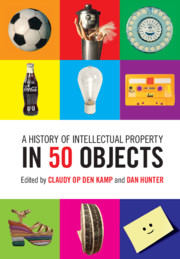Book contents
- Frontmatter
- Dedication
- Contents
- Acknowledgments
- Introduction: Of People, Places, and Parlance
- The Pre-Modern Period
- The Age of invention
- Modern Times
- The Consumption Age
- 26 Bell Transistor
- 27 Oral Contraceptive Pill
- 28 Photocopier
- 29 Elstar Apple
- 30 Chanel 2.55
- 31 Lego Brick
- 32 Barbie Doll
- 33 Coca-Cola Bottle
- 34 Zapruder Film
- 35 Audiotape Cassette
- 36 Action Figure
- 37 RAM-Chip
- 38 Football
- The Digital Now
- About The Contributors
26 - Bell Transistor
from The Consumption Age
Published online by Cambridge University Press: 12 June 2019
- Frontmatter
- Dedication
- Contents
- Acknowledgments
- Introduction: Of People, Places, and Parlance
- The Pre-Modern Period
- The Age of invention
- Modern Times
- The Consumption Age
- 26 Bell Transistor
- 27 Oral Contraceptive Pill
- 28 Photocopier
- 29 Elstar Apple
- 30 Chanel 2.55
- 31 Lego Brick
- 32 Barbie Doll
- 33 Coca-Cola Bottle
- 34 Zapruder Film
- 35 Audiotape Cassette
- 36 Action Figure
- 37 RAM-Chip
- 38 Football
- The Digital Now
- About The Contributors
Summary
THE TRANSISTOR IS arguably one of the most profound enabling technologies to be invented in the 20th century. It enhances long-distance telephony and forms the basis of the microchips that enable computers. Without transistors we would not have computers, the internet, cloud Computing, artificial intelligence, or the emerging “internet of things.” In fact, I would not be writing this entry on my PC.
The story of how the transistor was developed is a classic case of big business technological development: problem-driven research, scientificjealousy, egg-shell egos. government largesse, bonhomie, betrayal, the power of induction over deduction, savvy research management, and the emergence of what we nowadays call “Silicon Valley.” The transistor spawned major enterprises for those who had both the early insight to spot its technical potential and the skill to manage people. Our story also falls that sweet juncture of successful curiosity-driven discovery and use-driven research.
Transistors are tiny switches. If triggered by electricity they can do two things: amplify sounds—hence the transistor radio or “tranny” that burst onto the consumer market in the mid-1950s—or store information in binary format. Millions of transistors can record millions of zeros and ones. Combined with the mathematics described by Shannon's Information Theory, these binary numbers can record integers, letters, sentences, and a range of information. If you can miniaturize the size of the transistor, a single chip can contain billions of them and thus store considerable information.
Transistors were invented to solve the telephonic problem of sound amplification. In the 1930s, Mervin Kelly, the research director of the research and development arm of AT&T—the famed Bell Labs—recognized that the telephone market was not going to grow unless there was a better way to amplify sound over long distances. He felt that the answer might lie in a newly discovered class of materials called semiconductors. In 1936, he hired Bill Shockley to pursue this idea.
Although Kelly appointed a whole scientific team to work with Shockley, two people were pivotal: John Bardeen, a theoretical physicist, and Walter Brattain, an experimental physicist. The whole team was close-knit, but in December 1947 Bardeen and Brattain jointly made the first practical transistor, a device known as a point-contact transistor.
- Type
- Chapter
- Information
- A History of Intellectual Property in 50 Objects , pp. 216 - 223Publisher: Cambridge University PressPrint publication year: 2019
- 1
- Cited by

